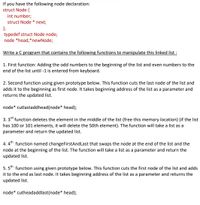
Computer Networking: A Top-Down Approach (7th Edition)
7th Edition
ISBN: 9780133594140
Author: James Kurose, Keith Ross
Publisher: PEARSON
expand_more
expand_more
format_list_bulleted
Question

Transcribed Image Text:If you have the following node declaration:
struct Node {
int number;
struct Node * next;
};
typedef struct Node node;
node *head,*newNode;
Write a C program that contains the following functions to manipulate this linked list :
1. First function: Adding the odd numbers to the beginning of the list and even numbers to the
end of the list until -1 is entered from keyboard.
2. Second function using given prototype below. This function cuts the last node of the list and
adds it to the beginning as first node. It takes beginning address of the list as a parameter and
returns the updated list.
node* cutlastaddhead(node* head);
3. 3° function deletes the element in the middle of the list (free this memory location) (if the list
has 100 or 101 elements, it will delete the 50th element). The function will take a list as a
parameter and return the updated list.
4. 4th function named changeFirstAndLast that swaps the node at the end of the list and the
node at the beginning of the list. The function will take a list as a parameter and return the
updated list.
5. 5th function using given prototype below. This function cuts the first node of the list and adds
it to the end as last node. It takes beginning address of the list as a parameter and returns the
updated list.
node* cutheadaddlast(node* head);
Expert Solution
This question has been solved!
Explore an expertly crafted, step-by-step solution for a thorough understanding of key concepts.
Step by stepSolved in 2 steps with 1 images

Knowledge Booster
Similar questions
- -)Write a C++ program that presents a menu for the user. The menu should consist of the following: Create a linked list of 5 nodes containing names and phone numbers. Insert a new structure in the linked list. (between the 4 and the 5 node) Modify an existing structure in the linked list.(modify node 4) Delete an existing structure from the list (delete node 5) Exit from the program Note: based on the user’s selection the program should execute a function to satisfy the request. (Items: 3, 4, and 5,)arrow_forwardc++arrow_forwardC++Create a text file storage for the list of movies and store your those movies in a linked list when you retrieved them from the text file. They must also be stored in a linked list data structure during processing. Saving back to the text file will be done when the user chooses to Exit the Program.arrow_forward
arrow_back_ios
arrow_forward_ios
Recommended textbooks for you
 Computer Networking: A Top-Down Approach (7th Edi...Computer EngineeringISBN:9780133594140Author:James Kurose, Keith RossPublisher:PEARSON
Computer Networking: A Top-Down Approach (7th Edi...Computer EngineeringISBN:9780133594140Author:James Kurose, Keith RossPublisher:PEARSON Computer Organization and Design MIPS Edition, Fi...Computer EngineeringISBN:9780124077263Author:David A. Patterson, John L. HennessyPublisher:Elsevier Science
Computer Organization and Design MIPS Edition, Fi...Computer EngineeringISBN:9780124077263Author:David A. Patterson, John L. HennessyPublisher:Elsevier Science Network+ Guide to Networks (MindTap Course List)Computer EngineeringISBN:9781337569330Author:Jill West, Tamara Dean, Jean AndrewsPublisher:Cengage Learning
Network+ Guide to Networks (MindTap Course List)Computer EngineeringISBN:9781337569330Author:Jill West, Tamara Dean, Jean AndrewsPublisher:Cengage Learning Concepts of Database ManagementComputer EngineeringISBN:9781337093422Author:Joy L. Starks, Philip J. Pratt, Mary Z. LastPublisher:Cengage Learning
Concepts of Database ManagementComputer EngineeringISBN:9781337093422Author:Joy L. Starks, Philip J. Pratt, Mary Z. LastPublisher:Cengage Learning Prelude to ProgrammingComputer EngineeringISBN:9780133750423Author:VENIT, StewartPublisher:Pearson Education
Prelude to ProgrammingComputer EngineeringISBN:9780133750423Author:VENIT, StewartPublisher:Pearson Education Sc Business Data Communications and Networking, T...Computer EngineeringISBN:9781119368830Author:FITZGERALDPublisher:WILEY
Sc Business Data Communications and Networking, T...Computer EngineeringISBN:9781119368830Author:FITZGERALDPublisher:WILEY

Computer Networking: A Top-Down Approach (7th Edi...
Computer Engineering
ISBN:9780133594140
Author:James Kurose, Keith Ross
Publisher:PEARSON

Computer Organization and Design MIPS Edition, Fi...
Computer Engineering
ISBN:9780124077263
Author:David A. Patterson, John L. Hennessy
Publisher:Elsevier Science

Network+ Guide to Networks (MindTap Course List)
Computer Engineering
ISBN:9781337569330
Author:Jill West, Tamara Dean, Jean Andrews
Publisher:Cengage Learning

Concepts of Database Management
Computer Engineering
ISBN:9781337093422
Author:Joy L. Starks, Philip J. Pratt, Mary Z. Last
Publisher:Cengage Learning

Prelude to Programming
Computer Engineering
ISBN:9780133750423
Author:VENIT, Stewart
Publisher:Pearson Education

Sc Business Data Communications and Networking, T...
Computer Engineering
ISBN:9781119368830
Author:FITZGERALD
Publisher:WILEY